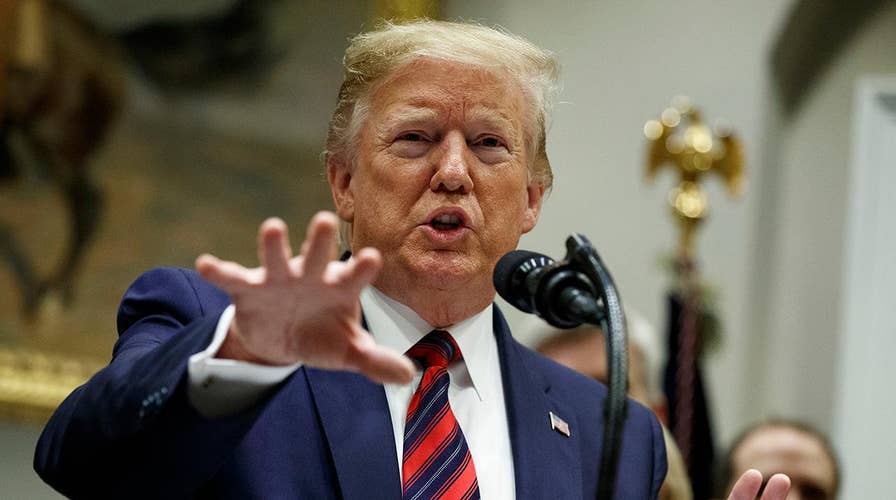President Trump hopeful of trade deal with China as additional sanctions loom
The imposition of new U.S. tariffs on $200 billion worth of Chinese imports could be a dangerous next step in a trade dispute between the world's two largest economies; chief White House correspondent John Roberts reports.
Round 11 of U.S.-China trade talks wrapped with no deal Friday, after President Trump raised tariffs on $200 billion worth of Chinese imports from 10 percent to 25 percent. Beijing was close to a deal a week ago. Then China balked.
Wall Street is reacting to the uncertainty. So are American farmers and businesses.
"Tariffs will make our Country MUCH STRONGER, not weaker," the president tweeted Friday. "Just sit back and watch! In the meantime, China should not renegotiate deals with the U.S. at the last minute."
TRUMP SAYS OBAMA LET CHINA GET AWAY WITH 'MURDER,' TOUTS TARIFFS AS TRADE STANDOFF HEATS UP
How can Trump appear so calm? He doesn’t like tariffs any more than you do. He actually wants U.S.-China trade to grow – but not until China changes two decades of bad behavior.
Trump and Chinese President Xi Jinping left themselves plenty of diplomatic wiggle room this week. The tariffs don’t hit goods already in transit, which staves off their impact until late May. Trump also knows the Chinese can't immediately find alternative markets for $539 billion in goods, and that should keep them at the table.
The president was careful to delay tariffs for the rest of the $325 billion in products imported from China. That’s his style, and it’s an important point.
Sure, Trump likes to talk and tweet. But when it comes to action, he has proven quite methodical, even cautious, with the tools of U.S. power, both military and economic. True to form, he rolled out the China tariffs in small batches over the past year. He’s taking measured steps.
But the single most important element is Trump’s determination not to lose this trade war. He’s picked his battle.
Realize that for Trump, this trade war began long ago. And he’s long since accepted that America lost the first battle by not doing enough to engage China on trade rules from 2001 to 2017.
The U.S.-China trade deficit was about $118 billion (inflation-adjusted) when China joined the World Trade Organization in 2001 and started exporting goods with no tariffs. Last year it was $419 billion. True, U.S. sales to China went up, but not enough.
It should never have gone on for so long. Over the past 20 years, we let China gush out exports without getting fair access to China’s market.
Yes, U.S. companies do a lot of business in China. But Beijing throws in barriers and restrictions that limit sales. When Japan and Europe grew their exports from the 1950s to the 1980s, they abided by rules and allowed U.S. businesses to operate in their countries under fair terms. They were allies, not thieves.
The world hoped the Chinese would behave well. After all, they’re a powerhouse. They invented fireworks and gunpowder and sent spaghetti home with Marco Polo 700 years ago.
China was the world’s biggest economic power back when America was t3 colonies trading animal skins and using whiskey for money. There’s a reason your dishes are called “china.”
Beginning in the 19th century, internal turmoil, world events, some British imperialism, and a failure to industrialize knocked China off its game. Then came war and communism. America rose in the 20th century while China was in the dirt.
In the 1990s, China stepped slowly back into the world market. Fine. Trade grew slowly at first. But China set up all sorts of tricks and barriers to its huge domestic market. The result? Massive trade imbalances. In the U.S., Democrats and Republicans both turned a blind eye. You know the rest.
The peak came when China surpassed Canada as the top U.S. trading partner in 2015. Get this. Canada, with a population of 37 million people, buys $298 billion in U.S. goods per year. China, with 1.38 billion people, buys less than half that amount – just $120 billion in U.S. goods.
Even granting that Canada is our neighbor, which facilitates trade, these numbers show something is very wrong with China’s trade practices.
The Chinese want a win-win. They’ve said so. The U.S. wants fairness and reciprocity. U.S. Trade Representative Robert Lighthizer won’t back down on key issues like intellectual property, forced technology transfer, tariff and non-tariff barriers, and enforcement of agreements.
Australia went 21 rounds negotiating its China trade deal back in 2015. But it worked out. China and Australia ended up with a positive deal for both sides, with 95 percent of products tariff-free.
CLICK HERE TO GET THE FOX NEWS APP
Trump doesn’t want long-term tariffs. He wants a deal, and the markets know it.
As Trump once said, sometimes by losing a battle you find a new way to win the war. What you need generally is enough time and a little luck.

